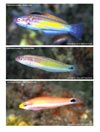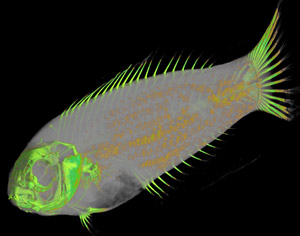The imagery on this page is supporting material for a paper entitled A New Species of Halichoeres (Teleostei: Labridae) from the Western Gulf of Mexico, by D.C. Weaver and L.A. Rocha (2007, Copeia 2007:798-807). The abstract is as follows:
A new labrid fish, Halichoeres burekae, is described from specimens collected at Stetson Bank, Flower Garden  Banks National Marine Sanctuary (FGBNMS), in the northwestern Gulf of Mexico over claystone, sponge, and coral substrata. The bright
purple, blue-green, and yellow body coloration, and anterior black pigmentation of the dorsal fin in the terminal male, large black irregular spot at the base of the caudal peduncle, salmon body coloration, yellow snout in the initial stage/female, and diagnostic differences in the mitochondrial DNA cytochrome b gene separate this species from all other western Atlantic labrids. Adult H. burekae were observed in small schools along the reef crest mixed with Thalassoma bifasciatum and Chromis multilineata, and small juveniles were observed in mixed schools with juvenile Clepticus parrae. It
feeds primarily on calanoid copepods and other plankton and is a close relative of H. socialis from Belize. This species is currently known from the FGBNMS and reefs off Veracruz, Mexico, in the western Gulf of Mexico.
Banks National Marine Sanctuary (FGBNMS), in the northwestern Gulf of Mexico over claystone, sponge, and coral substrata. The bright
purple, blue-green, and yellow body coloration, and anterior black pigmentation of the dorsal fin in the terminal male, large black irregular spot at the base of the caudal peduncle, salmon body coloration, yellow snout in the initial stage/female, and diagnostic differences in the mitochondrial DNA cytochrome b gene separate this species from all other western Atlantic labrids. Adult H. burekae were observed in small schools along the reef crest mixed with Thalassoma bifasciatum and Chromis multilineata, and small juveniles were observed in mixed schools with juvenile Clepticus parrae. It
feeds primarily on calanoid copepods and other plankton and is a close relative of H. socialis from Belize. This species is currently known from the FGBNMS and reefs off Veracruz, Mexico, in the western Gulf of Mexico.

Literature:
ALLEN, G. R., AND D. R. ROBERTSON. 1994. Fishes of the Tropical Eastern Pacific. University of Hawaii
Press, Honolulu.
BARBER, P. H., AND D. R. BELLWOOD. 2005. Biodiversity hotspots: evolutionary origins of biodiversity in
wrasses (Halichoeres: Labridae) in the Indo-Pacific and new world tropics. Molecular Phylogenetics
and Evolution 35:235253.
HUMANN, P., AND N. DELOACH. 2002. Reef Fish Identification Guide, Third Edition. New World Publications, Jacksonville, Florida.
KNOWLTON, N., L. A. WEIGT, L. A. SOLORAZANO, D. K. MILLS, AND E. BERMINGHAM. 1993. Divergence in
proteins, mitochondrial DNA, and reproductive compatibility across the Isthmus of Panama. Science 260:16291632.
LEVITON, A. E., AND R. H. GIBBS, JR. 1988. Standards in herpetology and ichthyology. Standard symbolic
codes for institutional resource collections in herpetology and ichthyology. Supplement No. 1: additions and corrections. Copeia 1988:280282.
LEVITON, A. E., R. H. GIBBS, JR., E. HEAL, AND C. E. DAWSON. 1985. Standards in herpetology and
ichthyology: part I. Standard symbolic codes for institutional resource collections in herpetology
and ichthyology. Copeia 1985:802832.
PATTENGILL, C. V., B. X. SEMMENS, AND S. R. GITTINGS. 1997. Reef fish trophic structure at the Flower
Gardens and Stetson Bank, NW Gulf of Mexico. Proceedings of the Eighth International Coral Reef
Symposium 1:10231028.
POSADA, D., AND K. A. CRANDALL. 1998. Model Test: testing the model of DNA substitution. Bioinformatics
14:817818.
RANDALL, J. E., AND J. E. BO¨ HLKE. 1965. Review of the Atlantic labrid fishes of the genus Halichoeres. Proceedings of the Academy of Natural Sciences of Philadelphia 117:235259.
RANDALL, J., AND P. LOBEL. 2003. Halichoeres socialis: a new labrid fish from Belize. Copeia 2003:
124130.
ROCHA, L. A. 2004. Mitochondrial DNA and color pattern variation in three western Atlantic Halichoeres (Labridae), with the revalidation of two species. Copeia 2004:770782.
ROCHA, L. A., AND R. S. ROSA. 2001. Halichoeres brasiliensis (Bloch, 1791), a valid wrasse species
(Teleostei: Labridae) from Brazil, with notes on the Caribbean species Halichoeres radiatus (Linnaeus,
1758). Aqua 4:161166.
TAMURA, K., AND M. NEI. 1983. Estimating the number of nucleotide substitutions in the control region of
mitochondrial DNA in humans and chimpanzees. Molecular Biology and Evolution 15:512526.










